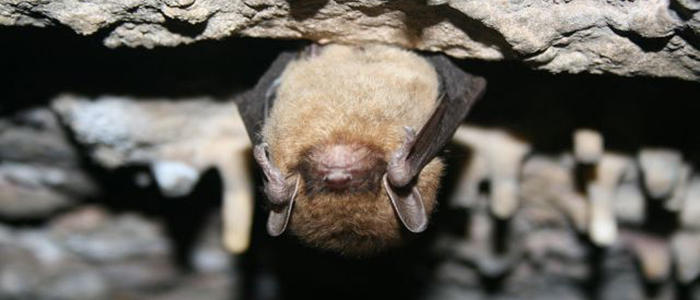In New York State, bats are showing signs of recovery from white-nose syndrome
Posted on March 29, 2017 by Benjamin Thompson
Bats in North America are in trouble. Millions of them have died over the past few years, over an area that stretches for thousands of miles, from Nova Scotia in Eastern Canada to Nebraska in the heart of North America. This area is moving steadily west, although isolated cases have already been found in Seattle on the US West Coast.
The disease responsible for killing the bats is known as white-nose syndrome, caused by the fungus Pseudogymnoascus destructans. Some populations have suffered catastrophic declines of up to 90%, and the northern long-eared bat – one of the most common in North America – has completely disappeared from some areas.

Death from white-nose syndrome is a cruel and drawn out affair. Some bats roost over the winter in ‘hibernacula’ – often caves or mines – and lower their temperature to that of the ambient environment. Hibernation allows the bats to survive off their limited fat stores, while they wait for winter to end and their insect prey to reappear.
P. destructans grows best in low temperatures, making it ideally suited to attack bats as they sleep. Hibernation also suppresses the bats’ immune systems, so they have little chance to defend themselves. The fungus manifests itself as a white powdery-film on the muzzle and wings of infected individuals (hence its name), and causes them to wake up early, burning through their meagre reserves.
Thankfully there may be some good news, as research published a few months ago in Phil. Trans. R. Soc. B has shown that some bat populations appear to be rallying. The work was led by Dr Kate Langwig when she was at the University of California, Santa Cruz, now a postdoctoral fellow at the Harvard T.H. Chan School of Public Health. Kate previously worked for the New York State Department of Environmental Conservation when white-nose syndrome emerged, and saw first-hand the effect the disease had on the bats.
“At the time we didn’t really know what it was – we thought it could’ve been something weird happening climatically in the caves that was affecting the bats,” she explains.
“In the caves you saw these really disheartening mortality events, with affected bats hanging out in groups by the entrance during the middle of winter,” Kate says.
Bats with white-nose syndrome usually die a few months after being infected and the fungus P. destructans can persist in hibernacula during the warmer months, allowing it to re-infect any surviving bats the following winter.
The reason that white-nose syndrome has been so devastating is that New World bat populations have never been exposed to it before. The fungus appears to be endemic to Eurasia, where bats seem to tolerate it better, but it wasn’t until 2006 that the disease was seen in North America. And as bats can’t fly across oceans, there’s little to no chance of naturally breeding in resistance from the Old World.
After an initial crash in numbers, some populations of little brown bats (Myotis lucifugus) living in New York State bounced back and persist at between 5%–30% of their original size. Kate and her colleagues compared these populations with ones at the invasion front that were still in decline, to look for clues as to why the New York bats were surviving.
Their work showed that while P. destructans was able to grow on both groups of bats, the resilient populations had lower fungal growth than those in decline, although there were differences in timing of infection or initial fungal infections in early winter.
For reasons that are unclear, the New York bats are able to fight back. It could be that these bats have evolved an immune response that kicks in when P. destructans growth reaches a particular level. Or maybe they have a different collection of micro-organisms on their skin – known as a microbiome – that protects them from the fungus.
This seems plausible, particularly as there is increasing interest in how the skin microbiome of some amphibians appears to protect them from the otherwise lethal fungal disease chytridiomycosis. Whether that is the case with bats remains to be seen.
While this is clearly great news for little brown bats in one locality, it is intriguing as to why this has only happened in a few populations in one area. It’s tempting to consider relocating resistant bats to other areas to jump-start repopulation, but North America is a big place, and the effect of the local environment needs to be considered. For instance, the American South is considerably hotter than the Northeast: might this speed up the fungus’s growth, negating the resistance?
Little brown bats are very slow breeding, so it’ll take a long time for resistance to spread. They’re also just one out of a huge number of species, and resistance will have to emerge independently in each one, before it’s too late.
Regardless, this work is welcome news, as it sheds some light on how we might prevent, or protect against, this devastating disease. Kate explained her feelings upon seeing a recovering population of little brown bats:
“When we began to see reductions in fungus and healthy bat behaviour in the hibernacula – bats clustering normally, and not trying to fly out in winter – it was an incredibly welcome sight.
“We hope this work can provide insight into how bats are surviving with disease. Our future research will continue to explore whether this mechanism will evolve across space, or among species, to ultimately determine who will remain after this disease has swept the continent.”
